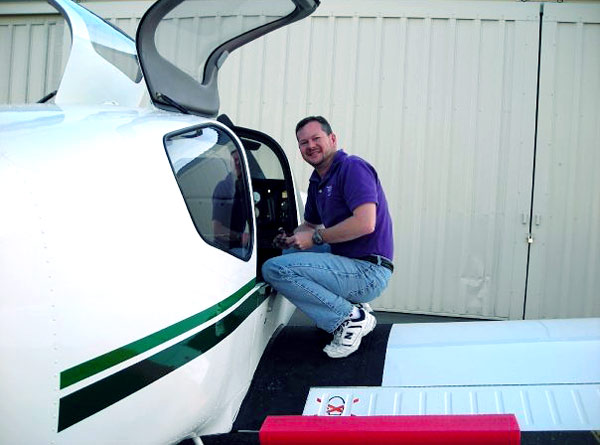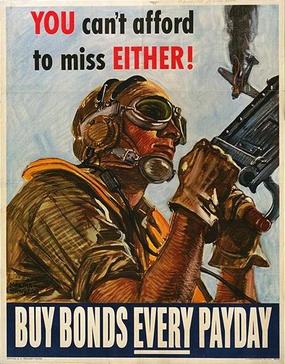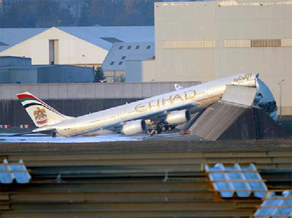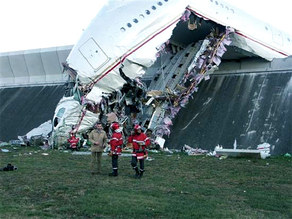Entries in Aviation (26)
Do Miracles Really Happen?

By now everyone knows about US Air 1549 pilot “Sully” Sullenberger’s textbook ditching in the Hudson River. Was it a miracle? Even those that don’t believe in God have to recognize a miracle when they see one!
Cousin Mike says it was a miracle, all right. “No one died, the passengers standing on the wing appeared to be walking on water, news of the ditching knocked Obama out of the headlines for 24 hours, no one in government could take credit, and no one claimed it was George Bush’s fault.” I can’t argue with that logic!
Mike also sent a timely link to this story about another successful ditching, this one involving PanAm flight 943 in the Pacific in late 1956 with no fatalities or serious injuries. Another miracle? You bet! It’s another good story worth a read. And watch the video at the end taken by the guys aboard the Coast Guard ship that just “happened” to be in the area to rescue the passengers and flight crew.
Nope, you can’t tell me miracles don’t happen!
Friday Fly-by - Mike's Socata TB20
Instead of military aircraft in this week’s fly-by, we’re featuring my friend and dive buddy, Mike, and his Socata TB20 Trinidad. (Wife Michele refers to it as “his beloved”.)

I’ve traveled with Mike and Michele to many of the most exotic dive destinations in the world and, besides a love of world class underwater adventure, we share an affinity for general aviation. Michele shares this photo and cockpit video of Mike and the TB20 in flight.
Suggestion: If you have the bandwidth, move your cursor to the triangle at bottom right and select HQ (high quality) viewing.
WWII Posters - 1
WWII Posters played an important roll during WWII, helping mobilize the nation. Inexpensive, accessible and ever-present, the poster was an ideal agent for making war aims the personal mission of every citizen. Government agencies, businesses and private organizations issued an array of poster images linking the military front with the home front—calling upon every American to boost production at work and at home.
Deriving their appearance from the fine and commercial arts, posters conveyed more than simple slogans. They expressed the needs and goals of the people who created them. I was just a kid then, but I remember seeing many of them, still hanging in garages and plants long after the war ended. They represented a way of life, a collective spirit to do what was necessary to win the war and bring our boys home.
Cousin Mike emailed a collection of such posters to me the other day and I thought I’d share some of them over the next few weeks. I wonder how we’d respond today if asked to make such a commitment to the war effort. (Click to enlarge)

 Above: The Treasury Department financed the war through the sale of bonds and stamps to the public. War bond posters called upon all citizens to share in “ownership” of the war.
Above: The Treasury Department financed the war through the sale of bonds and stamps to the public. War bond posters called upon all citizens to share in “ownership” of the war.
To be continued…
Friday Flyby - Think You're a Good Pilot?
Talk about a rudder throw! Mike sent this with the notation, “And you think you’re a good pilot… whew!”
Impressive, but to be honest, Mike, I think it’s “CG” trickery. For one thing, right after the starboard wing “falls off”, the plane begins to spiral (counterclockwise) “into” the remaining wing which, I believe, would be aerodynamically impossible. In addition, and this is purely speculative, the plane looks a little “wrong” when it first lands, a little too “CG”. I’ll do some research into it, but you’re a pilot; what do you think?
Anyone else have an opinion?
The Tale of the Arab Flight Crew
The brand spanking new Airbus 340-600, the largest passenger airplane ever built, sat in its hangar in Toulouse, France without a single hour of airtime. Enter the Arab flight crew of Abu Dhabi Aircraft Technologies (ADAT) to conduct pre-delivery tests on the ground, such as engine runups, prior to delivery to Etihad Airways in Abu Dhabi. The date was November 15, 2007.
The ADAT crew taxied the A340-600 to the run-up area. Then they took all four engines to takeoff power with a virtually empty aircraft. Not having read the run-up manuals, they had no clue just how light an empty A340-600 really is.
The takeoff warning horn was blaring away in the cockpit because they had all 4 engines at full power. The aircraft computers thought they were trying to takeoff but it had not been configured properly (flaps/slats, etc.) Then one of the ADAT crew decided to pull the circuit breaker on the Ground Proximity Sensor to silence the alarm.
This fools the aircraft into thinking it is in the air.
The computers automatically released all the brakes and set the aircraft rocketing forward. The ADAT crew had no idea that this is a safety feature so that pilots can’t land with the brakes on.
Not one member of the seven-man Arab crew was smart enough to throttle back the engines from their max power setting, so the $80 million brand-new aircraft crashed into a blast barrier, totaling it.
The extent of injuries to the crew is unknown, for there has been a news blackout in the major media in France and elsewhere. Coverage of the story was deemed insulting to Moslem Arabs. Finally, the photos are starting to leak out (click thumbnails to enlarge). Link
Thanks Mike and Michael!
You May Remember...
…eight years ago, when Southwest Airlines Flight 1455 from Las Vegas overshot the runway at Burbank, crashed through a metal blast wall and then through the airport perimeter wall and came to rest on Hollywood Way, a four-lane city street, near a Chevron gas station.

Amazingly, only two passengers received serious injuries. Even more amazing, check out the gas prices!
H.T. to Mike!
C-17 Globemaster on Final Approach
I thought some of you military aviation buffs might appreciate this nice photo of a C-17 Globemaster on final…

Via AFP archives.
Friday Fly-by - F-22 Raptor Maneuverability
This week’s fly-by features a montage of video clips of the F-22 Raptor’s first full tactical air show demonstration, performed at Langley AFB in April 2007 by pilot Major Paul Mogataken. It includes cobras, backflips, super-high-alpha flight, hovering with its nose pointed straight up, super-fast pitch-ups, and some sonic shock condensation cones and wingtip vortex contrails (“vapor”) at the very end.
As you may already know, the F-22 is essentially invisible to the enemy in combat; in simulated war games, its pilots consistently “kill” the enemy while remaining undetected. In addition, the Raptor has the fastest cruise speed of any aircraft currently flying (MACH 1.5 - 1.75, depending on whom you ask). It’s capable of breaking the sound barrier while in a straight up vertical climb, fully loaded, and is highly sophisticated in how it manages, shares and integrates information and presents it to the pilot.
During this exhibition, the USAF allowed one more thing about the F-22 to be shown to the public: its amazing maneuverability. No other American fighter in history has so empowered its pilot and provided such impressive combat performance capabilities.
Son of Concorde
Flying at more than twice the speed of Concorde and five times the speed of sound, this hypersonic airliner is set to be the future of modern air travel. Looking like a supersonic passenger plane from Gerry Anderson’s Thunderbirds, the revolutionary aircraft with a top speed of 3,400mph aims to fly between London (or Brussels) and Sydney in under five hours. Billed as the “Son of Concorde”, the commercial plane is designed to carry 300 passengers and will reach speeds of Mach 5 – five times the speed of sound.

The ground-breaking aircraft - known as the A2 – is the work of British engineers at Reaction Engines Limited in Oxfordshire. At 433ft long (132m), the A2 is half the length of the Titanic and weighs 400 tons, lighter than a Boeing 747. Yet despite its length, the aircraft will be able to land on current international airport runways. In addition, its hi-tech liquid hydrogen-powered engines will produce few carbon emissions, making air travel much greener.
Is there a downside? Well, apparently there will be no windows, so everyone will have to jocky for aisle seats. More…
Cousin Mike thought my readers might enjoy listening to the conversations between Kennedy Ground Control and Speedbird2 immediately prior to the last New York-London flight of the Concorde on October 24, 2003, as it prepared for its final departure and subsequent retirement from flight service. Unless you’re familiar these communications, it may sound a little confusing. “Speedbird2 Heavy” (the Concorde) is coordinating taxi and takeoff instructions with “Ground [Control]” (the tower) during which the air traffic controllers offer appreciation and farewells to Concorde, and the flight crew responds. It’s a memorable moment in aviation history.
To listen, click here. (Requires Quicktime)
Friday Fly-by - German Bo-105
The German Bo-105 is a light twin engine multi purpose utility helicopter initially developed by Bölkow, and then built by Messerschmitt-Bölkow-Blohm (MBB) which now belongs to the Eurocopter Group. Eurocopter sold the Bo 105 until 1997. It was replaced by the new EC 135.
Being the first light twin-engine helicopter in commercial service, it gained widespread use over rural areas (police and EMS/medevac) as well as offshore. The four-blade hingeless main rotor with composite blades ensures extreme maneuverability. All main systems (hydraulics, electric, fuel, lubrication) were designed to be fully redundant. The pilot is Charlie Zimmermann, German helicopter aerobatic champion.
Thanks Michael!
Runway Modifications at Heathrow After Crash Landing
Davey says, “Following the recent crash landing at London’s Heathrow Airport, there have been some modifications to runway lighting…”

Flightgear Simulator
If you like flight simulators, you’ll enjoy this application I just learned about from Michael. Called FlightGear, it’s open-source, so as long as you abide by the terms of the license, you’re free to download, use and share it.
And while it may be free, don’t think for a moment that it’s not full featured. Professional polish and attention to detail are evident in flight variables like wind effects and real-time day/night. That’s the beauty of open-source—programmers around the world contribute to a project.
Flightgear includes real-world scenery taken from photographs and comes with the San Francisco area pre-installed. But you can visit the FlightGear Web site to get additional settings from around the world, including thousands of real airports.
FlightGear runs on Windows, Mac OS-X, Linux, FreeBSD, Solaris and IRIX platforms allowing the user to “fly” their platform of choice. If you’re a flight-sim enthusiast, give it a try. New challenges keep your flight-sim skills honed, and you sure can’t beat the price!
Friday Fly-By - Sukhoi SU-35 Extreme Maneuvers
The SU-35 is the prototype for the SU-37, a super-maneuverable thrust vectoring Russian fighter. Two Lyulka AL-37FU vectored-thrust afterburning turbofans (30,855 lb thrust each) give the aircraft it’s extreme flight characteristics. Amazing!
Thanks Michael!
The City of Richmond is For Sale

No, not Richmond, California or Richmond, Virginia. The plane! The plane!
I can’t believe this beautiful piece of aviation history is still for sale! $2700/offers? Hell, I’m tempted to buy it myself to donate to the McClellan Aviation Museum here in Sacramento. Instead, I think I’ll try to get the McClellan folks together with the seller. This beautifully restored airplane needs a home where folks will appreciate it!
Regular contributer Dave gave me the heads up on this. Here are some of the particulars:
It’s a 1929 Ford 4-AT-E Tri-Motor restored to an extraordinarily high standard. In 1929 it was delivered as a new passenger plane to Mamer Flying Service in Spokane, Washington. It was later sold to K-T Flying Service of Honolulu and was at Pearl Harbor on December 7, 1941. Brought back to the mainland in 1946 by a private owner, it was leased by TWA for their 1949 20th anniversary celebration. It then went to an agricultural operator in Idaho and was modified as a sprayer and also as one of the pioneer forest fire fighting air tankers. Johnson Flying Service in Montana flew it for several years to drop Smoke Jumpers and supplies to fire fighters.
Since 1969 the plane has been privately owned and hangar stored by Dolph Overton and was part of his Wings and Wheels museum collection. It is currently owned by the Overton Family Trust, which was created by Mr. Overton to fund the plane’s restoration and facilitate its sale.
In November, 2005 the Tri-Motor was flown from Goldsboro, NC to Richmond, VA where (until recently) it was on public display at the Virginia Aviation Museum. It has also graced the cover of the March, 2006 issue of Trade-A-Plane. Currently hangared at Petersburg-Dinwiddie Airport in central Virginia, it is available for viewing and inspection by appointment only.
Here’s the link for all the details, more photos and to contact the seller direct. It’s a beautiful piece of aviation history. I’d love to see it find a new home.
This is interesting. I’d been checking the web listing for this plane daily for more than week to make certain it didn’t sell before my post. It had been listed at $3,000, then dropped to $2,700. I thought it was a steal and I guess it was!
Turns out the post generated a barrage of purchase inquiries about purchasing the $2,700 vintage aircraft. That caused the owners to check the listed price on their site and, what do you know, they had inadvertently left off the trailing three zeros! That’s right, they meant to say $2,700,000! Whoops!
So I guess I won’t be buying it, and neither will the folks at the McClellan Air Museum.
It proves the point, I guess, that when it sounds too good to be true, it’s probably a misprint.Hiding an Aircraft Factory
During World War II, the Army Corps of Engineers needed to hide the Lockheed Burbank Aircraft Plant to protect it from possible Japanese air attacks. They covered it with camouflage netting and trompe l’oeil to make it look like a rural subdivision from the air. As this series of 9 photographs illustrates, the ruse was quite effective, allowing workers to carry out their daily routines without fear of becoming targets…
Tip o’ the hat to Davey!







